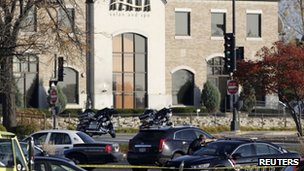 Washington, October 22: Three people were killed and four others injured when a suspected gunman, who was later found dead, opened fire at a spa in a Milwaukee suburb shopping centre in the US state of Wisconsin.
Washington, October 22: Three people were killed and four others injured when a suspected gunman, who was later found dead, opened fire at a spa in a Milwaukee suburb shopping centre in the US state of Wisconsin.
President Barack Obama, who was informed about yesterday's incident, was told by his top national security officials that the incident was not an act of terrorism, White House Press Secretary Jay Carney, said.
"The President was told there was an active shooter in Brookfield, Wisconsin. He was informed that the shooting did not appear to be terrorism-related," Carney said in a statement.
Obama was briefed by FBI Director Bob Mueller, his Chief of Staff Jack Lew and Advisor for Homeland Security John Brennan.
The FBI is at the site and is supporting the Brookfield, Wisconsin police department while they respond to the ongoing situation, he said.
The President has instructed the FBI to ensure that the state and local officials have full support of the Federal government, Carney added.
According to local police and federal investigating agencies, the suspect was identified as Radcliffe F Haughton, the 45-year-old husband of a spa worker.
Haughton, an African-American, was later found dead.
Brookfield police Chief Daniel Tushaus said they believe the suspect had placed an improvised explosive device inside the building where the shooting took place, which he said was hampering the their efforts to clear the building.
This is the second such incident in the state within three months after a US Army veteran went on rampage at a Gurdwara killing six worshippers on August 5.
The injured were taken to the same hospital in Milwaukee where the injured of the Gurdwara shooting were treated.
The last of the injured of the August Gurdwara shooting was released from the hospital last week.
Meanwhile expressing shock over the incident, Wisconsin Governor Scott Walker said the state administration will provide all kind of support to the victims and their families.
"Senseless acts of violence leave us with heavy hearts and many questions. Our state will stand with the victims and their families, and we will provide them with the law enforcement and community support they need to heal in the coming days," Walker said.
Republican vice presidential candidate Paul Ryan, who comes to Wisconsin, expressed shock over the incident.
"As our community continues to heal from August's tragic violence, our thoughts and prayers are with today's victims and their loved ones. Our gratitude also goes to the first responders who rushed to save lives and secure the scene," he said.
"We will not allow the evil responsible for this heartbreaking event to triumph over the spirit of the people of Wisconsin. I ask all Americans to keep those affected by this event in their hearts, minds, and prayers today," Ryan said.





Comments
Add new comment